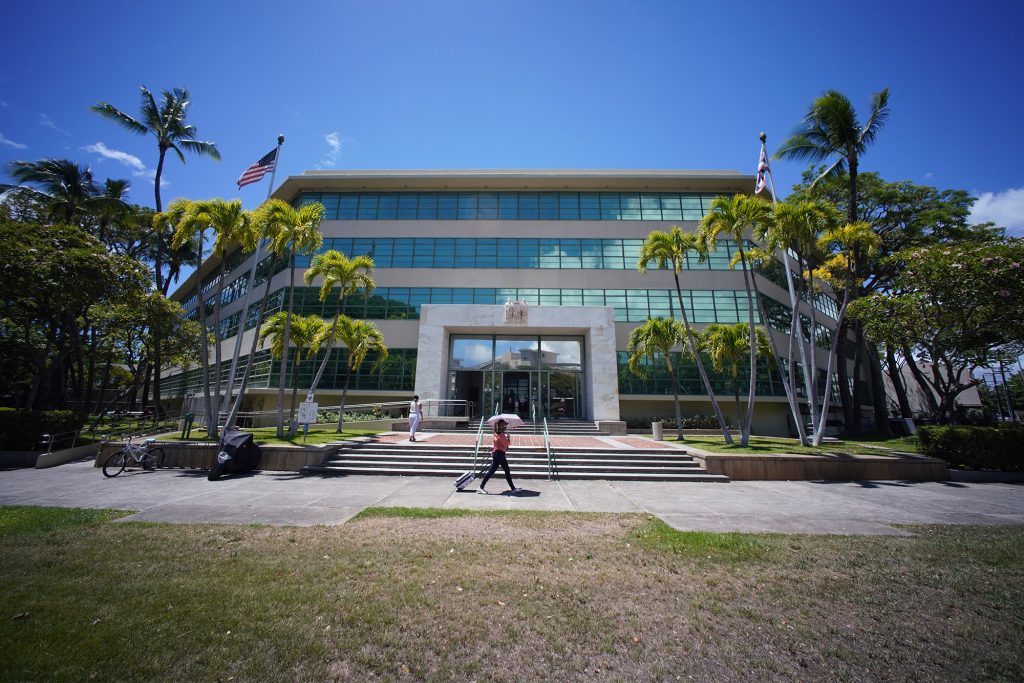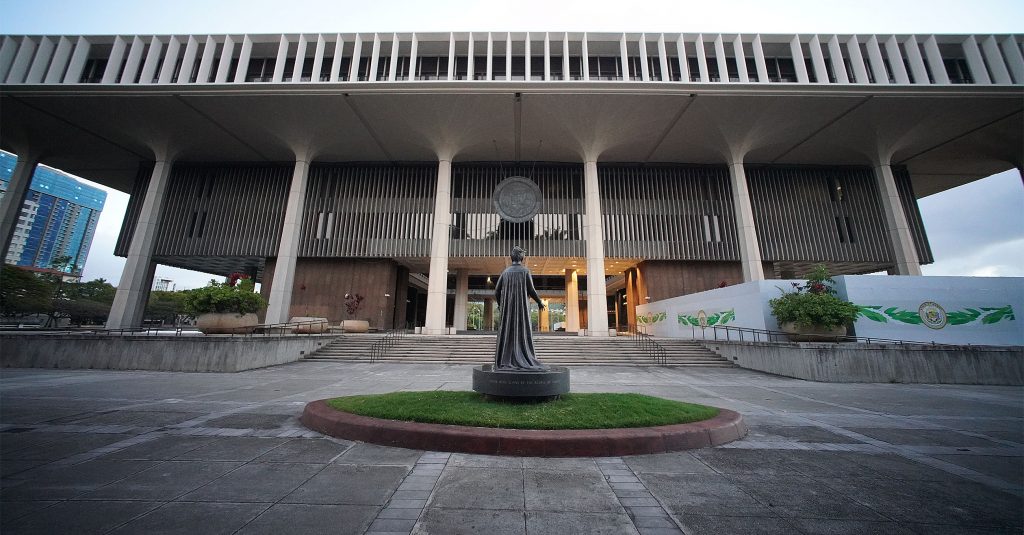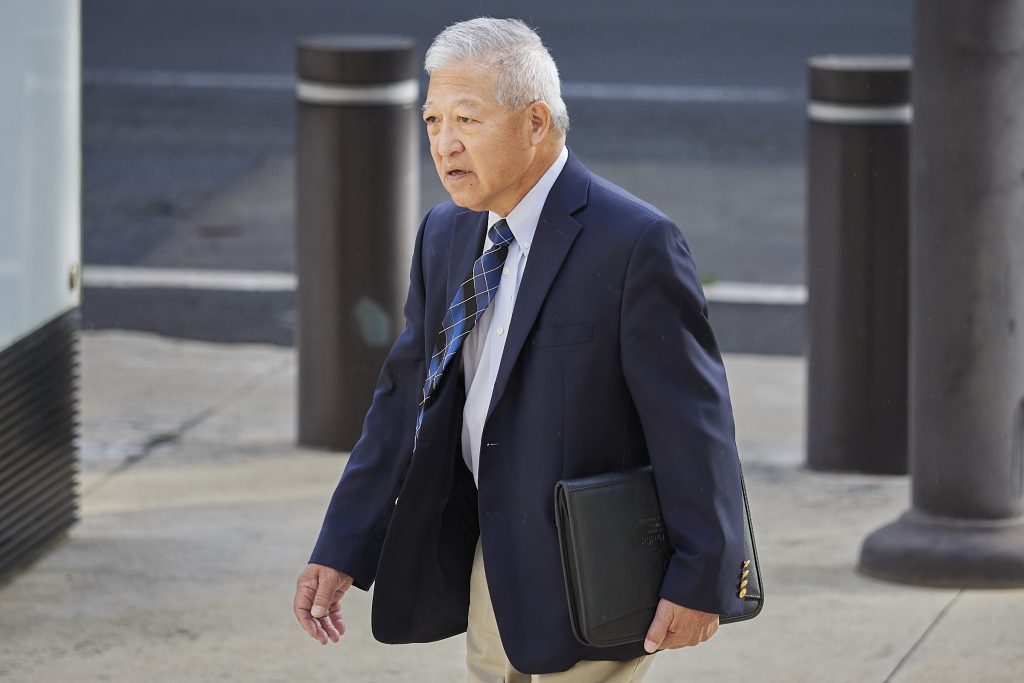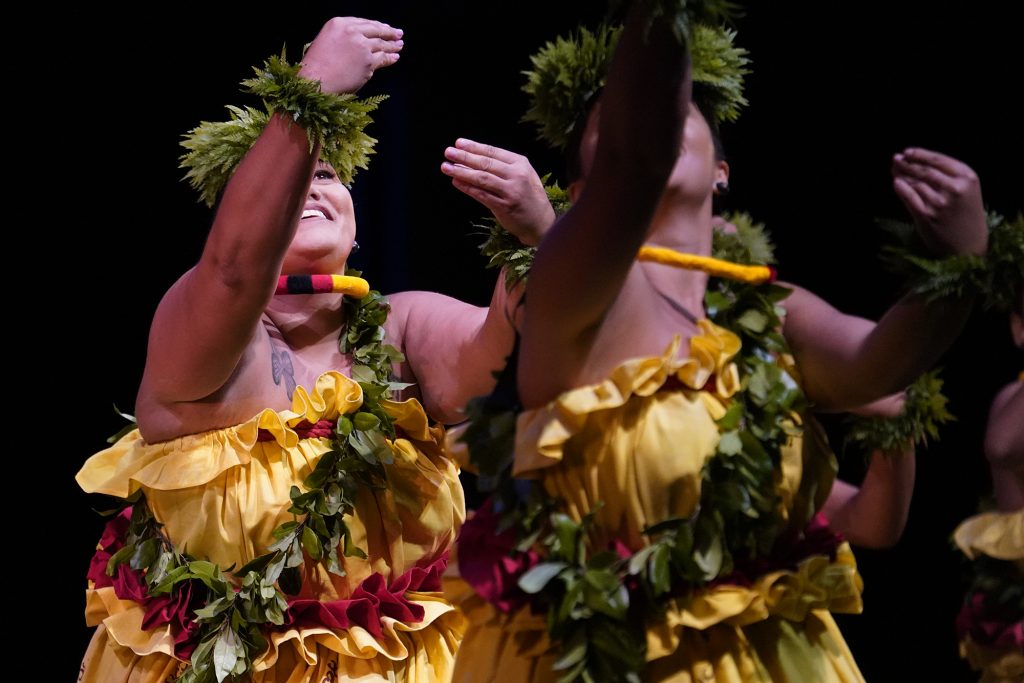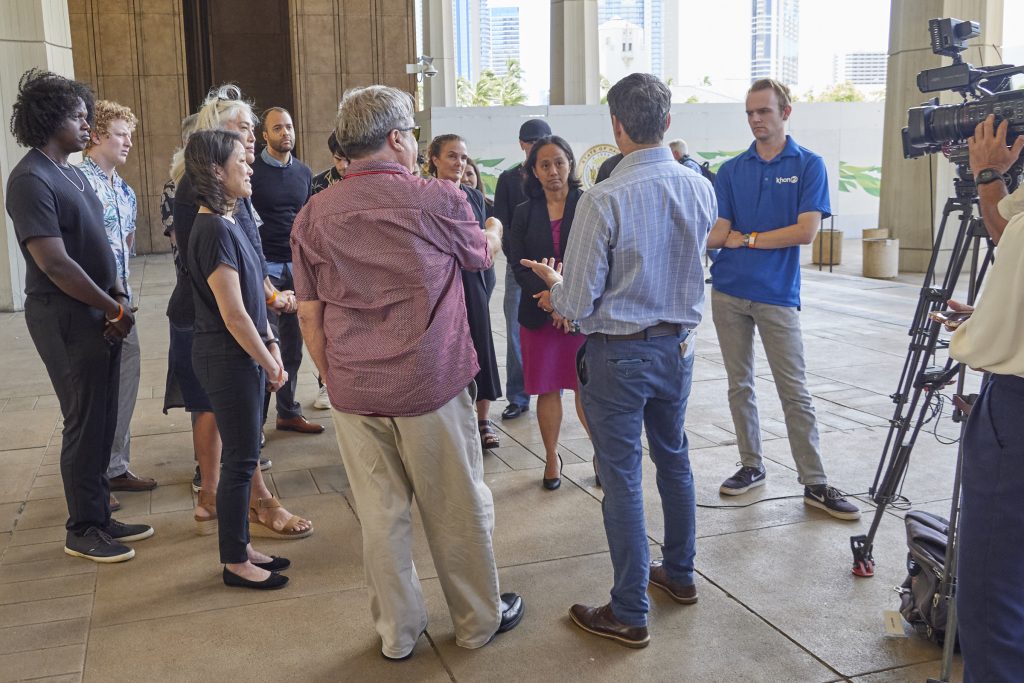Editors Note: This is the first of two stories examining efforts to narrow the achievement gap among the growing numbers of Micronesian students in Hawaii.
Last spring, Jonathan Loomis couldn’t shake off a nagging concern.
The social studies department chairman at McKinley High School in Honolulu noticed that in the six years he has taught at the school, no Micronesian student had ever enrolled in his AP classes — even though those students make up 11 percent of the student body.
If they weren’t registering themselves, Loomis thought, he would encourage them in that direction. He went to the registrar, looked for rising juniors and seniors with good grades and attendance who had not enrolled in an AP class of any kind at the school. The effort yielded 10 names.
“I was looking for students who could be good AP students,” he said. “I was looking specifically for Micronesian students, because other ethnicities were already fairly represented.”

With some help from Dusty Santos, who is a special education teacher from the island state of Pohnpei and the Micronesian Club advisor, a few meetings with the students, a form sent to parents and some follow-up, Loomis succeeded in getting seven of the 10 kids to sign up for his AP Psychology class this school year.
“I was very happy with the turnout,” Loomis said. “I feel it was time and effort well spent.”
Partial funding for these stories was provided by the Solutions Journalism Network, which supports reporting on how communities are responding to critical issues.
Support
Loomis is part of multiple efforts by Hawaii schools and community groups to broaden educational opportunities for Micronesian students, whose enrollment has grown swiftly in recent years, but who are at risk of getting left behind in the public school system.
Many schools around Hawaii have adopted a hands-on approach to reach these kids — and their families. There are training workshops for teachers centered around Micronesian culture, events tailored to familiarize Micronesian parents with the schools and community-organized events that recognize Micronesian student academic achievement.
The number of Micronesian students in Hawaii’s public schools grew from about 1,100 in the late 1990s to more than 8,100 in 2014, according to state data. The challenges have grown as well.
Pacific Islanders, along with Native Hawaiians, make up the largest percentage of students who are chronically absent. They’re at high risk of dropping out, especially at the high school level, due in part to English Language Learner requirements. Additionally, federal data from 2015-16 shows Native Hawaiians and Pacific Islanders are suspended or disciplined far more often than other students.
But hidden in such statistics are the socioeconomic challenges within their communities: high rates of poverty, parents working two or three jobs and students obligated to stay home to take care of a younger sibling or accompany a grandparent to the doctor to translate.
“It’s not an intelligence issue, it’s a preparedness issue,” said Loomis, of Micronesians’ performance in schools.
Micronesian migration to Hawaii and elsewhere in the United States has grown dramatically during the last few decades.
That’s due to the 1986 Compact of Free Association, a treaty that allows citizens of the Marshall Islands, Palau and the Federated States of Micronesia (Chuuk, Pohnpei, Yap and Kosrae) to enter the U.S. visa-free for an indefinite period of time in exchange for U.S. military control in those places. The U.S. has had a military presence in the islands since World War II, which includes performing nuclear testing in the Marshall Islands.

View Larger MapThree Micronesian nations make up the Compact of Free Association.
The COFA migrants often come to the U.S. for better economic opportunity and education, in addition to seeking health treatment such as dialysis. (Read Civil Beat’s 2015 special project on Micronesia.)
But many students struggle after arriving in Hawaii, in part because of language barriers and the gulf in understanding their cultures.
“There’s a general lack of basic knowledge about Micronesia in Hawaii. There are issues of racism, discrimination, people not understanding where students are coming from,” said David Kupferman, assistant professor at Minnesota State University Moorhead who has written a book about education in Micronesia. (Clarification: A previous version of the story identified Kupferman as assistant professor of education at University of Hawaii West Oahu. He formerly taught there.)
While the hostility she sensed from her fellow students was never overt, it showed up in a “respectfully discriminatory” way, recalled Diana Lokebol, who attended Waipahu High from 2011 to 2014 before transferring to Campbell High so she could fulfill high school graduation credits.
“‘Oh, she’s Marshallese,’” Lokebol said, mimicking a disparaging tone.
Those encounters would discourage Marshallese students from asserting themselves in class, said Lokebol, who is now studying at Leeward Community College.
“Marshallese kids wouldn’t speak up, because they’d be judged,” she said.
On a recent Saturday morning, several dozen Marshallese youth sat on folding chairs in the fellowship hall of a church near downtown Honolulu, engaged in an introductory exercise.
They were told to turn to a neighbor, someone they didn’t already know, and talk story. “How are you?” “What did you do last weekend?” “What is your favorite food?”
Most of the participants were born in the U.S. and speak English comfortably. The organizers wanted to encourage the Marshallese youth to explore the power of dialogue to find their voice in a place that hasn’t always felt so welcoming.
“That’s how you can change people’s perspectives — when you talk with them. One of the ways you can make things better is to talk story with them,” Christy MacPherson, a representative of Faith Action for Community Equity, or FACE, told the students.

After the exercise, a middle school-aged Marshallese boy raised his hand, and said a question that often comes to mind for him is, “Do we have a right to be here?”
“For him to ask that question, it was sort of a mirror of what he’s experiencing out there. To me, it was telling. This young kid is dealing with these kinds of issues in his own mind,” MacPherson said afterwards.
The boys and girls were being honored at an annual event known as Marshallese Education Day, which recognizes students who’ve maintained a 3.0 GPA or higher for two consecutive quarters.
About 50 students were honored, but organizers believe there actually are many more Marshallese academic standouts fanned out across Oahu. Since schools cannot disclose which students meet this benchmark due to privacy laws, it’s up to the students and parents to come forward.
That’s not so easy in the Marshallese community, where shining a spotlight on oneself is often discouraged. Two high-school honorees interviewed by Civil Beat said their pride was not theirs alone.
“It’s an honor. It’s not mostly about me, I’m trying to honor my family,” said Yashu Lanki, a Marshallese senior at McKinley High who has maintained a 4.0 GPA and who will be heading to Northwest Christian University in Eugene, Oregon, this fall.
“Not only am I doing this for me, I’m doing it for the Marshallese community,” said 16-year-old Kano Balos, a junior at Kaimuki High.
Today, a handful of DOE schools are more than 25 percent Micronesian, clustered around Kalihi, Palolo Valley and central Honolulu. Many of those schools are seeing gaps in academic achievement.
At Kaimuki High, where Micronesian students comprise a fifth of the student body, the high school graduation rate in 2016-17 was 50 percent among Pacific Islanders (which includes kids from Samoa and Tonga but not Native Hawaiians), compared with 64 percent for the school as a whole.
At Dole Middle School, where Micronesians are a quarter of all students, 42 percent of Pacific Islanders are chronically absent. Eighth-grade literacy — defined as meeting grade-level standards for reading comprehension — is 42 percent for all students, but falls to 33 percent for Pacific Islanders, according to the most recent Strive-HI data.

Teachers say one of the biggest challenges for newer arrivals navigating the education system is becoming proficient in English.
At Honolulu’s Fern Elementary, where Micronesians — mostly from Chuuk — make up a third of the student body, about 160 of the 452 students are in English Language Learner classes, according to fourth-grade teacher Mark Atta.
The students who require the most ELL instruction get pulled out of regular classrooms for 45 minutes a day to learn vocabulary, basic conversational English and computer-based lessons.
Regardless of whether an ELL student may be ready to progress to the next grade, they are automatically moved up, which isn’t always the best outcome for the student, according to Atta.
School administrators “think they’re going to socially and emotionally scar them if they hold them back a grade, but I don’t necessarily agree with that,” he said. “I think it will be beneficial if they do stay back a grade. I think in the long run it would make them more successful.”
“We hear many stories in middle and high school, those kids who struggle in elementary school, they end up dropping out. They can’t catch up and they’re passed on and they end up dropping out.”
Complicating matters, the longer a student stays in ELL, the harder it may be to accumulate enough high school graduation credits, according to Sheila Matsuda, who authored a paper on Micronesian student education in Hawaii for her master’s thesis.
“If you look at how hard it is to get high school graduation credits for these kids, it’s no wonder … dropping out is a problem,” she said. “The older you get, the harder it is to get out of ELL. You can’t take courses that offer graduation requirements until you pass out of ELL.”
Another challenge for students, particularly those living in public housing, is simple access to the internet — often, a necessity for homework, according to Innocenta Sound, a Hawaii community advocate originally from Chuuk and the founder of Pacific Voices at Kokua Kalihi Valley, a nonprofit community center which runs after-school programs.

Sound recalled one student who wasn’t able to send an email for a school assignment because he was leaving out the .edu at the end of an address.
“They’re already at a disadvantage,” she said. “They don’t get (access) from the beginning, those small basic knowledge of computer (skills).”
Sound said she’s also observed Micronesian students who feel abandoned. They might be totally engaged while at Kalihi Elementary or Fern Elementary, but upon entering middle school, don’t exude the same level of enthusiasm.
“Their spirits look like they just sucked out of them,” Sound said. “I worry they will not even want to go to high school. That fear is making them not go to school because they’re thinking, ‘What’s the use? They’re going to treat me the same way they treat me in middle school.’
“Then you will see some of them drop out.”
Many teachers say enlisting community help, including from families, is essential. However, it’s been a challenge as many Micronesian parents don’t speak English or don’t routinely come to parent events.
A Kalihi-based community and education nonprofit, Parents and Children Together, has been hosting a 15-week session at rotating DOE schools called “Sunday’s Project” for Micronesian parents: these sessions teach parents how to develop a routine for their kids, read a report card and enforce positive discipline, according to organizers. This year, they are at Fern Elementary.
The school has also begun hosting an annual Family Picnic Day to reach Micronesian parents in a more informal setting. In addition, the school moved its open house, typically held several weeks into the new school year, to the first morning of the first day of school so the staff can catch more parents.

“If we hold a (Micronesian) parent workshop, we try and incorporate food into it somehow. It tends to bring more parents in,” Atta said. “We’ve seen that the parents are more willing to come if it doesn’t seem so formal and serious.”
Community members are also working to instill pride among students in their culture.
At the second-ever Micronesian Youth Summit held at University of Hawaii Manoa in March, thousands of students came to the campus from all over the state. They heard from recent Micronesian high school graduates and college students, a Marshallese professional who works as an attorney in Honolulu and various public officials, including the consul general of the FSM Consulate Office in Honolulu.
“When you leave this stage today and you go home, I want you to have a sense of pride much bigger than when you come here,” Joakim “Jojo” Peter, a Chuuk native and member of the Hawaii Civil Rights Commission, told the students. “I want you to know as many of your peers as possible. Shake their hands, look into their eyes, it’s all in who you are.”
“When you go out there and people ask, who are you? You say, ‘I am a Micronesian, and I am a proud daughter and son of Micronesians.'”
Teachers are also taking advantage of cultural training and professional development, such as a three-day workshop on Micronesian culture conducted through Honolulu Museum of Art.
Since launching in 2014, the workshop — offered on Oahu, Maui and the Big Island during the spring and summer — usually fills up in less than 24 hours and has a waitlist, according to Justin Davies, curriculum specialist and teacher liaison for the museum.
The Department of Education does not make these workshops mandatory and it’s up to the teachers to sign up individually — a method that’s more effective for now, says Mary Hattori, the director of Center for Teaching and Learning at Chaminade University.

Principals are also reaching out to Paul Hadik, executive director of Pacific Resources for Education and Learning, a former DOE educator on the Big Island who recently moved back to Hawaii with his family after more than two decades living and teaching in Chuuk and Kosrae. Hadik conducts training sessions for DOE staff and administrators to help them learn more about Micronesian culture and habits.
During a recent keynote during a teacher professional day at Washington Middle School, Hadik, a native of Philadelphia, offered up tips to teachers, such as finding out how many Micronesian kids in their class are related to one another. He also advised that singling a student out (either for a positive or negative reason) won’t work, and that walking a newly arrived student around the school and pointing out simple things like the water fountain can go a long way.
“Keep this in mind, everything is new,” he told teachers. “Be patient with these kids.”
“A lot of teachers assume that kids will walk through the door ready to learn. You have to be ready to help kids be ready to learn.” — Jonathan Loomis, McKinley High School teacher
Put a map up of the Pacific Islands in the classroom, he suggested, to show where their COFA students are from, learn some basic phrases in their language and connect with their church pastors, he said.
Relationship building, he said, is everything. Longer range, Hadik believes there should be an orientation of sorts for Micronesian families when they first arrive to the state, even the establishment of a DOE transition school so the move from their native country to Hawaii isn’t so stark.

Ruth Silberstein, a complex area superintendent for the Kaimuki-McKinley-Roosevelt school region, was principal of Palolo Elementary from 2001 to 2012, when the number of Micronesian students grew dramatically.
Today, more than half the elementary school’s student body is Micronesian — most live nearby in the Palolo public housing complex. Silberstein recalls it took about three years to really connect with the kids’ families, even if it was being receptive to a phone call home to let them know how things were going with their child.
But the school found strategies to identify potential. Silberstein recounts how Palolo Elementary’s chess team in 2003 and 2004 was comprised of Pacific Islanders and some Native Hawaiians, inspired by the chess lessons led by school volunteers from the Rotary Club.
“These kids could hardly speak English but they could understand math, numbers, they could understand chess,” she said. “We went to a chess tournament and Palolo challenged (private schools) Kamehameha, Punahou, Iolani.”
“Looking at all the (kids from) private schools, looking so nice and fresh in their outfits, and here we are, (the kids) in faded shirts. By golly, Palolo took second place.”
What’s important for Loomis, the AP teacher at McKinley, is that the Micronesian students at his school understand the opportunities that are available to them.
“A lot of teachers assume that kids will walk through the door ready to learn. You have to be ready to help kids be ready to learn,” he said.
He’s already looking to do the same recruitment strategy for AP students for next school year.
“Maybe they won’t pass the AP exam, get college credit and in the end won’t get to college,” he said. “But I want them to be exposed to that world. It’s sowing the seeds.”
Coming Thursday: A look at an ambitious, district-wide program in Arkansas to strengthen connections with Micronesian students and their families.
Thoughts on this or any other story? Write a Letter to the Editor. Send to news@civilbeat.org and put Letter in the subject line. 200 words max. You need to use your name and city and include a contact phone for verification purposes. And you can still comment on stories on our Facebook page.
 GET IN-DEPTH
REPORTING ON HAWAII’S BIGGEST ISSUES
GET IN-DEPTH
REPORTING ON HAWAII’S BIGGEST ISSUES
Civil Beat is a small nonprofit newsroom that provides free content with no paywall. That means readership growth alone can’t sustain our journalism.
The truth is that less than 1% of our monthly readers are financial supporters. To remain a viable business model for local news, we need a higher percentage of readers-turned-donors.
